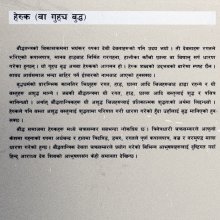Rupaka, Rūpaka: 26 definitions
Introduction:
Rupaka means something in Buddhism, Pali, Hinduism, Sanskrit, the history of ancient India, Marathi, Hindi. If you want to know the exact meaning, history, etymology or English translation of this term then check out the descriptions on this page. Add your comment or reference to a book if you want to contribute to this summary article.
Rupaka has 25 English definitions available.
Alternative spellings of this word include Rupak.
Images (photo gallery)
Languages of India and abroad
Sanskrit dictionary
[Deutsch Wörterbuch]
Source: Cologne Digital Sanskrit Dictionaries: Böhtlingk and Roth Grosses Petersburger WörterbuchRūpaka (रूपक):—(von rūpa und rūpay)
1) adj. a) in (angenommener) Gestalt erscheinend: śvanvatīrapsa.aso.rūpakā u.a [Atharvavedasaṃhitā 11, 9, 15.] — b) bildlich bezeichnend [Sāhityadarpana 308, 3. 5.] —
2) m. eine best. Münze, wohl eine Rupie [Varāhamihira’s Bṛhajjātaka S. 81, 12. fgg.] [Pañcatantra 127, 8. 252, 13.] [Pāṇini’s acht Bücher 5, 1, 48,] [Scholiast] [Rājataraṅgiṇī 6, 52. 60. 66.] suvarṇa [45.] svarṇa [Kathāsaritsāgara 78, 13.] das Geschlecht nur aus einer Stelle in [Varāhamihira’s Bṛhajjātaka S.] zu ersehen. Nach [YUKTIKALPATARU im Śabdakalpadruma] ist rūpaka n. als Gewicht = 3 guñjā . —
3) f. rūpikā Schwalbenwurz, Asclepias lactifera Lin. [Ratnamālā im Śabdakalpadruma] [Suśruta 1, 159, 15. 2, 64, 3. 102, 17.] rūpikāyāḥ payaḥ [282, 10.] —
4) n. a) am Ende eines adj. comp. = rūpa
1) a): giriṃ (so die ed. Bomb.) pratyūharūpakam bildend [Mahābhārata 3, 9981.] samādhistu tadevārthamātrābhāsanarūpakam bestehend in [Hemacandra’s Abhidhānacintāmaṇi 85]; vgl. [Oxforder Handschriften 186,b,38.] dantāntācitarūpakā (sic) = dāntāntācitā [Rāmāyaṇa 5, 13, 11.] maṇividrumavaiḍūryajālāntarita [Mārkāṇḍeyapurāṇa 23, 103.] — b) Figur, Bildniss: teṣāṃ puruṣarūpakamiva kṛtvā eine menschenähnliche Figur [Aitareyabrāhmaṇa 7, 2.] citre kimālikhāmīha rūpakam [Kathāsaritsāgara 55, 43.] īdṛgālikhya citre me dehi rūpakam [67.] — c) Erscheinungsform, Art: dve vāva khalvete brahmajyotiṣo rūpake [MAITRYUP. 6, 36.] — d) Metapher, Tropus [Hemacandra’s Anekārthasaṃgraha.3,90.] [Medinīkoṣa k. 148.] [kāvyādarśa.2,66. fgg.] [Sāhityadarpana 669. 676. fgg. 105,13. 299,18. 308,2. 7.] [KUVALAY. 14. fg.] [PRATĀPAR. 78,b.] [Oxforder Handschriften 87,a,13. 208,b,15. 211,b,9.] śliṣṭa [Mallinātha] zu [Śiśupālavadha 9, 36.] — e) Schaustück [Hemacandra’s Anekārthasaṃgraha] [Medinīkoṣa] [DAŚAR.1,7.] [Sāhityadarpana 273.] [Oxforder Handschriften 142,a, No. 290.] — f) = mūrtta (mūrtti?) [Medinīkoṣa] = dhūrta [Hemacandra’s Anekārthasaṃgraha] — Vgl. tapta, daśa, puruṣa, prati, bahu (f. rūpikā [Mahābhārata 1, 6077]), mahā, vi, su .
Source: Cologne Digital Sanskrit Dictionaries: Sanskrit-Wörterbuch in kürzerer FassungRūpaka (रूपक):—Adj. —
1) bildlich bezeichnend. —
2) m. — a) eine best. Münze , wohl eine Rupie [215,29.31.] [Āryabhaṭa 2,30.] — b) ein best. Tact [Saṃgitasārasaṃgraha 235.] tāla (so zu lesen [GĪT.S.23.] —
3) f. rūpakā Füchsin oder Schakalweibchen [Atharvaveda 11,9,15.] Vgl. im Zend urupi. —
4) f. rūpikā Schwalbenwurz , Asclepias lactifera. —
5) n. — a) = ^1. rūpa 1)a) [Agnipurāṇa 30,6.] Gewöhnlich am Ende eines adj. Comp. (f. ā) — b) Figur , Bildniss. — c) Erscheinungsform , Art. — d) Metapher , Tropus. — e) Schaustück. — f) *ein best. Gewicht , = 3 guñjā. — g) = mūrta oder dhūrta.
Sanskrit, also spelled संस्कृतम् (saṃskṛtam), is an ancient language of India commonly seen as the grandmother of the Indo-European language family (even English!). Closely allied with Prakrit and Pali, Sanskrit is more exhaustive in both grammar and terms and has the most extensive collection of literature in the world, greatly surpassing its sister-languages Greek and Latin.
See also (Relevant definitions)
Starts with (+9): Rupaka-karyakrama, Rupaka-katha, Rupakagramavijnana, Rupakakhyashadanga, Rupakalamkara, Rupakam, Rupakanritya, Rupakanta, Rupakaparibhasha, Rupakar-kalahru, Rupakara, Rupakara-kalaharu, Rupakaraka, Rupakaram, Rupakarin, Rupakarshanika, Rupakarshini, Rupakartar, Rupakartri, Rupakarupaka.
Ends with (+65): Abhedarupaka, Abhirupaka, Adhikatadrupyarupaka, Aksheparupaka, Anurupaka, Arupaka, Assarupaka, Avayavarupaka, Avayavavirupaka, Avayavirupaka, Aviddharupaka, Bahirupaka, Bahurupaka, Brahmanarupaka, Chandarupaka, Chhandarupaka, Dasharupaka, Dharmapratirupaka, Dvirupaka, Ekangarupaka.
Full-text (+142): Maharupaka, Rupakatala, Uparupaka, Taptarupaka, Rupakarupaka, Kalanja, Rupakanritya, Talarupakam, Rupakashabda, Lalamakarupaka, Makarupakam, Garbharupaka, Arupaka, Nisharuka, Shlishtarupaka, Bahurupaka, Upamarupaka, Aksheparupaka, Dasharupaka, Nataka.
Relevant text
Search found 40 books and stories containing Rupaka, Rūpaka, Rūpakā; (plurals include: Rupakas, Rūpakas, Rūpakās). You can also click to the full overview containing English textual excerpts. Below are direct links for the most relevant articles:
Alamkaras mentioned by Vamana (by Pratim Bhattacharya)
6: Definition of Rūpaka Alaṃkāra < [Chapter 4 - Arthālaṃkāras mentioned by Vāmana]
1-2: The number of Alaṃkāras (poetic figures) mentioned < [Chapter 5 - A Comparative study of the different alaṃkāras mentioned by Vāmana]
22: Definition of Viśeṣokti Alaṃkāra < [Chapter 4 - Arthālaṃkāras mentioned by Vāmana]
Sahitya-kaumudi by Baladeva Vidyabhushana (by Gaurapada Dāsa)
Text 10.44 [Rūpaka] < [Chapter 10 - Ornaments of Meaning]
Text 10.55 < [Chapter 10 - Ornaments of Meaning]
Text 10.53 < [Chapter 10 - Ornaments of Meaning]
Dasarupaka (critical study) (by Anuru Ranjan Mishra)
The description of rūpa, rūpaka, nāṭya, nṛtya and nṛtta < [Introduction]
Difference between the Daśarūpaka and the Nāṭyaśāstra < [Introduction]
The concise nature of the Daśarūpaka < [Introduction]
Satirical works of Kshemendra (study) (by Arpana Devi)
1.2. Rūpaka (metaphor) < [Chapter 4 - Literary study of the Three Satirical Works]
1. Alaṃkāra or the figures of speech (Introduction) < [Chapter 4 - Literary study of the Three Satirical Works]
Mudrarakshasa (literary study) (by Antara Chakravarty)
3.5. Use of Rūpaka-alaṃkāra < [Chapter 3 - Use of Alaṃkāras in Mudrārākṣasa]
1. Mudrārākṣasa as a Nāṭaka < [Chapter 1 - Introduction]
2. Classification and number of Alaṃkāras < [Chapter 3 - Use of Alaṃkāras in Mudrārākṣasa]
Gati in Theory and Practice (by Dr. Sujatha Mohan)
Relevance of Gati in Rūpakas < [Chapter 3 - Application of gati in Dṛśya-kāvyas]
Observations in Post-Bharata works < [Chapter 5 - Conclusion]
